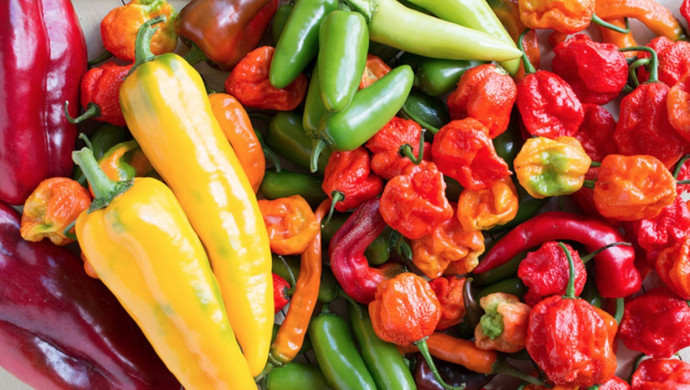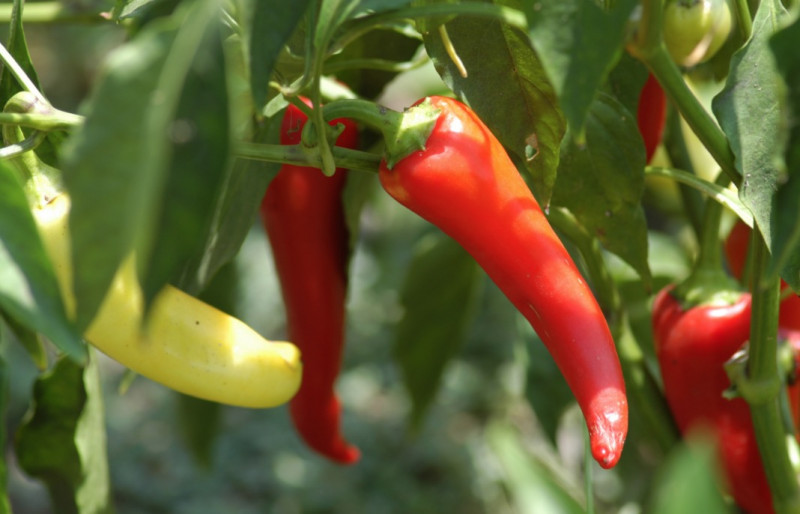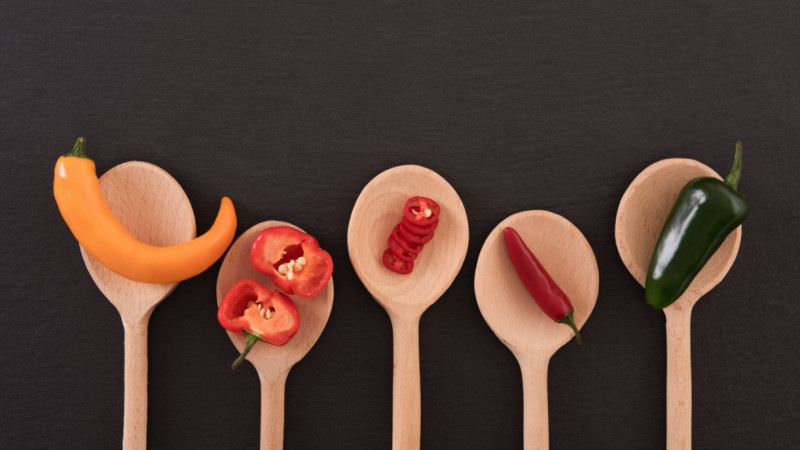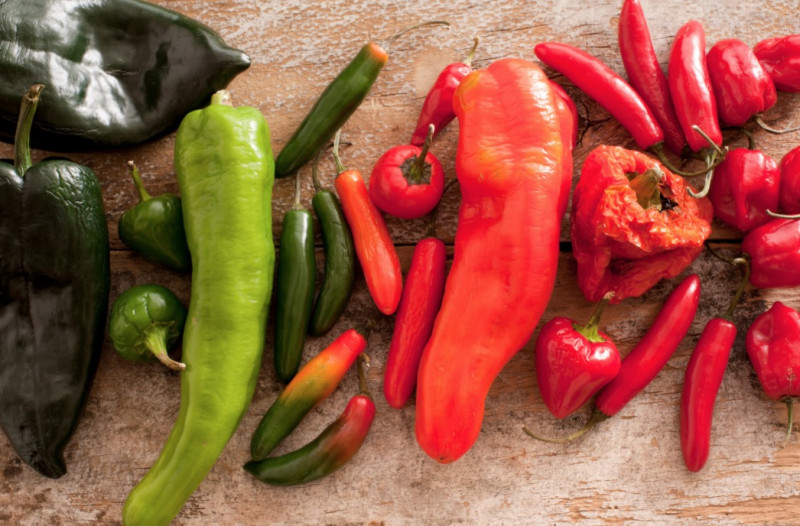Beginners Guide to Growing Chili Peppers + Types

Once reserved for ethnic dishes and hot sauce, chili peppers have become an extremely popular crop among many home gardeners. Their spicy, yet slightly sweet taste is undeniably delicious, and they can be used in an assortment of dishes.
The Aztec “chilli” or the Spanish “chili” is known to have existed as early as 700 B.C., but its birthplace remains a mystery, says Anne Lindsay Greer writing in Cuisine of the American Southwest. She also claims that all Chili peppers contain an element of unpredictability but insists that all Mexican food or all Chili peppers are not hot. More Chili peppers are produced and consumed than any other seasoning in the world. The hotness of each depends on the climate in which it is grown. Early South and Central American cultures used Chili peppers for medicinal purposes, currency, and as a discipline for disobedient children.

Chili peppers are thought to be an aid to digestion, to give protection from colds, and to cure everything of toothache to colic to an indifference toward romance. But after separating fact from folklore, some mystique from Chili peppers, certain facts remain undisputed:

A Chili Lineup
- ‘Habanero’. Hottest! Lantern-shaped, lime green to orange fruit. Aromatic and tasty in sauces or pickled. Wear gloves when preparing this chili.
- ‘Piquin’. Very hot, round, or slightly pointed, perennial in Mexico and south Texas.
- ‘Thai Pepper’. Tiny peppers (1 inch long), red when ripe, bred in Thailand, hot and the heat lingers. Use in Oriental dishes.
- ‘Anaheim “M” Chili’. An 8-inch long, tapering chili, which can be used green for rellenos and green chili sauce, or dry in red enchilada sauce. A medium-hot, long-bearing pepper.
- ‘Aji’. Hot, fruity Peruvian, a thin orange to red 3–5 inches long.
- ‘Centennial’. Tiny ornamental purple to white to red simultaneously. Hot pods are edible at all stages. (Named for our flag’s colors.)
- ‘De Arbol’. Treelike plant; 3–4 feet tall; thin 3–4-inch Chili peppers; hot and smoky. Good for drying.
- ‘Serrano’. Hot, small, slender, rounded chili. Serve fresh, dry, or pickled. Good in salsas. May be frozen if blanched first.
- ‘Cayenne’. Hot, short, slender. Best dried and ground for red-hot sauces. Used in Asian as well as Mexican and southwestern food.
- ‘Sandia Hot’. Very hot, thin-walled, best dried and ground. A standard for hot chili lovers. May be used green or red, fresh or dried.
- ‘Chimayo’. Pick green for your favorite stew or salsa. Dried and ground for red chili powder, it makes an excellent enchilada sauce.
- ‘Española’ Improved. A special short-season chili that will turn red and get hot even in northern climates. Narrow, pointed, and thin-walled. Use green or red.
- ‘Jalapeño’. Everybody’s favorite. Easily grown, prolific producer. A 3-inch, dark green, almost black chili with thick, meaty walls. Good for pickling or fresh. Finely chopped, adds a new dimension to corn bread.
- ‘Santa Fe Grande’. Short, thick, hot, yellow pepper, good in condiments or pickled. Very attractive as an ornamental.
- ‘Cascabel’. Medium hot, tough, round, and dark red, the 1-inch pod makes a dark, smoky chili pepper.
- ‘NuMex Eclipse’. Dark brown when ripe, medium hot. Adds color to vegetable dishes.
- ‘NuMex Sunrise’. Bright yellow when ripe, medium hot. May be used as a green chili.
- ‘Big Jim’. Five ‘Big Jims’ may weigh as much as one pound. This pepper is a perfect candidate for chili rellenos.
- ‘Vallero’. Dark red, medium hot. Use dried for red chili sauces and soups.
- ‘Mulatto’. Dark brown when dried, excellent for rellenos, very smoky flavor. 5 inches long, 2-inch pods are mild.
- ‘Guajillo’. Used dry in soups and salsas.
- ‘Andho’ (‘Poblano’). Large, heart-shaped, mild chili of excellent flavor. Use peeled ‘Poblano’ for rellenos, or cut into strips for soups and stews. Good dried.
- ‘Pasilla’. Almost black when dried, use for mole. Pods are mild.
- ‘Pimento’. Hungarians use for paprika. Heart-shaped, 4 inches long, red, mild, good stuffed or as a stuffing. Mild to hot.
Chili peppers evoke thoughts of spicy foods from hot places—dishes from the Southwest, Mexico, China, India, and Southeast Asia. Perhaps for this reason, many people mistakenly think that the only part of North America where chili peppers will grow is the hot and arid Southwest. But you can grow chili peppers just about anywhere in the United States and southern Canada, as long as you prepare your soil, nurture your seedlings properly, and provide the plants with their basic needs.
Growing Chili Peppers
Growing chili peppers isn’t really hard; even novice gardeners can successfully grow these chilies.
Soil
Choose a good quality soil or potting mix for growing your pepper that allows for good drainage. Add compost or manure before planting if you’d like.
Watering your pepper plants as with growing chili peppers in general, keep the soil moist but do not overwater them. For pepper plants in pots or containers, do not let the soil dry out completely. When peppers start to grow, cut back on your watering schedule a bit, but again, do not let the soil dry out.
Optimal growing temperature
The ideal growing temperature for chili pepper plants is between 70-90 f.
Best fertilizer
Tomato fertilizers work well for chili pepper plants, as do compost and well-rotted manure. A good 5-10-10 fertilizer is usually sufficient for peppers. Work it into the soil before transplanting, about 3 pounds per 100 square feet. You may use a solution of fish emulsion and seaweed.
Sun
Chili peppers grow nicely in full sun. They will grow in partial shade, but they won’t be as productive. A sunny spot is best. I have very successfully grown many varieties of chili peppers under my backyard deck, which is about 12 feet high. There is partial shade, but the garden gets a good dose of sunlight, so they grow very well.
Most chili pepper plants will only last a season in your garden, but if you transplant them and bring them indoors, and treat them to good conditions, you can keep them through the year and possibly longer. Some people have reported keeping their pepper plants for 3 years or longer.
Tips
- Space the chili pepper plants 18 – 36 inches apart with about 2 -3 feet between rows. The plants will eventually grow to nearly 3 feet high.
- Do not over water your pepper plants
- Do not overfertilize your pepper plants
- Pinch your pepper plants for bushier plants

